机器学习-Sklearn-11(支持向量机SVM-SVC真实数据案例:预测明天是否会下雨)
import pandas as pd
import numpy as np
from sklearn.model_selection import train_test_split
weather = pd.read_csv(r"D:\whole_development_of_the_stack_study\RS_Algorithm_Course\Practical\machine_learning\08_09_10_11SVM_01\weatherAUS5000.csv",index_col=0)
weather.head()

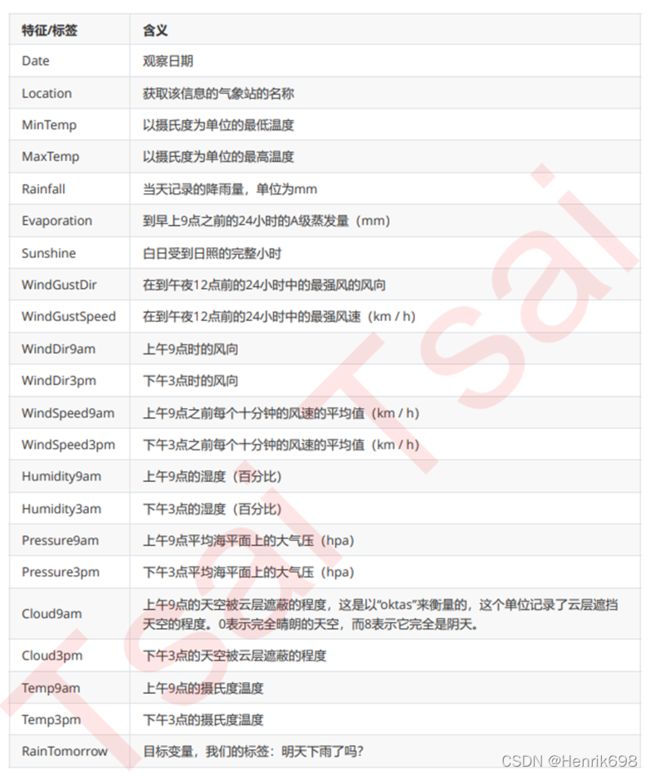
X = weather.iloc[:,:-1]
Y = weather.iloc[:,-1]
X.shape

X.info()
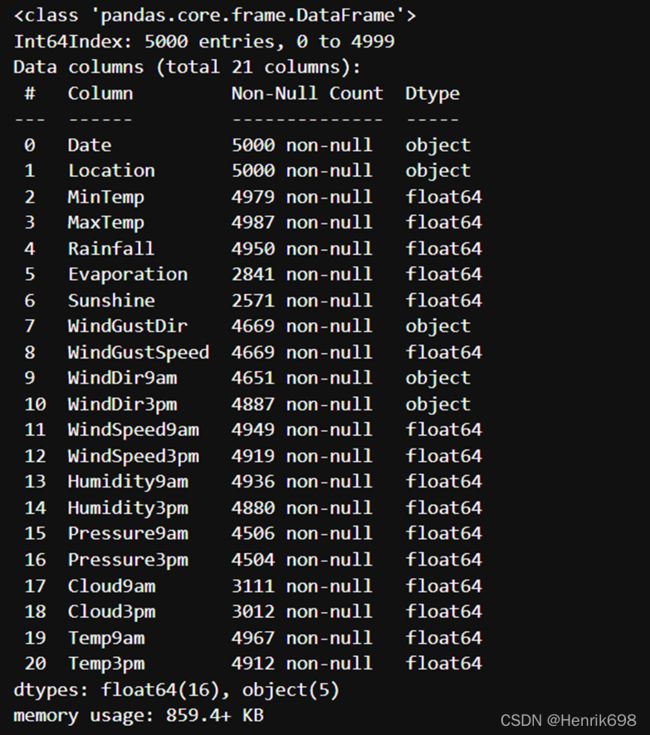
X.isnull().mean()
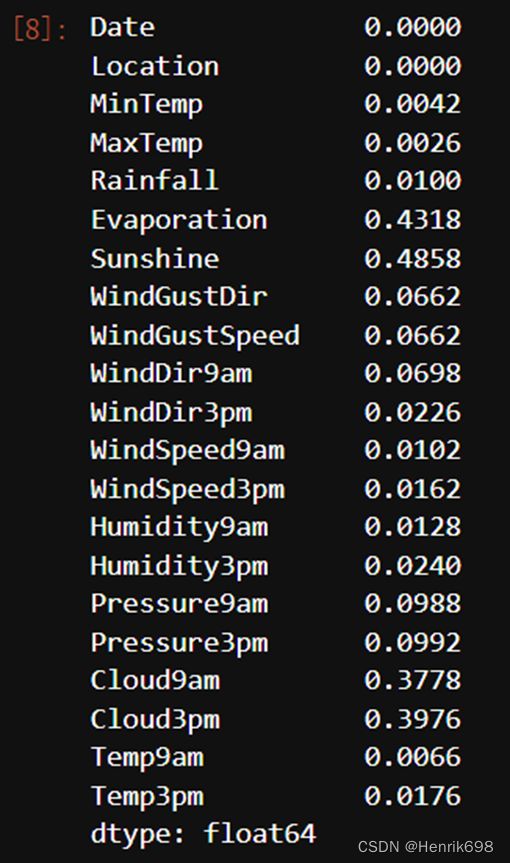
Y.shape

Y.isnull().sum()

np.unique(Y)

Xtrain, Xtest, Ytrain, Ytest = train_test_split(X,Y,test_size=0.3,random_state=420)
Xtrain.head()

for i in [Xtrain, Xtest, Ytrain, Ytest]:
i.index = range(i.shape[0])
Xtrain

Ytrain

Ytrain.value_counts()

Ytest.value_counts()

Ytrain.value_counts()[0]/Ytrain.value_counts()[1]

from sklearn.preprocessing import LabelEncoder
encorder = LabelEncoder().fit(Ytrain)
Ytrain = pd.DataFrame(encorder.transform(Ytrain))
Ytest = pd.DataFrame(encorder.transform(Ytest))
Ytrain
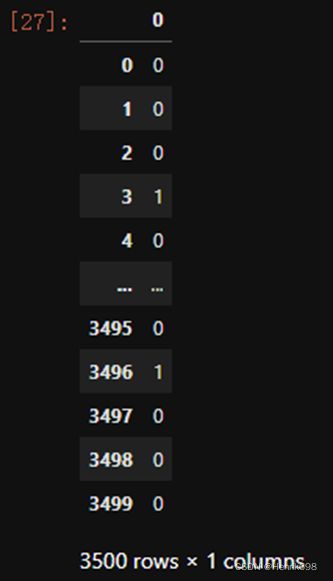
Ytest
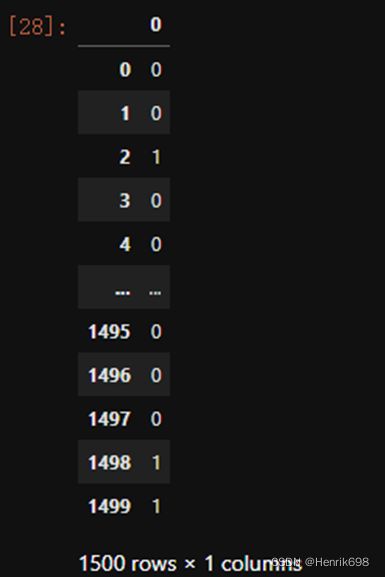
Ytrain.to_csv(r"D:\whole_development_of_the_stack_study\RS_Algorithm_Course\Practical\machine_learning\08_09_10_11SVM_01\Ytrain.csv")
Xtrain.describe([0.01,0.05,0.1,0.25,0.5,0.75,0.9,0.99]).T

Xtest.describe([0.01,0.05,0.1,0.25,0.5,0.75,0.9,0.99]).T
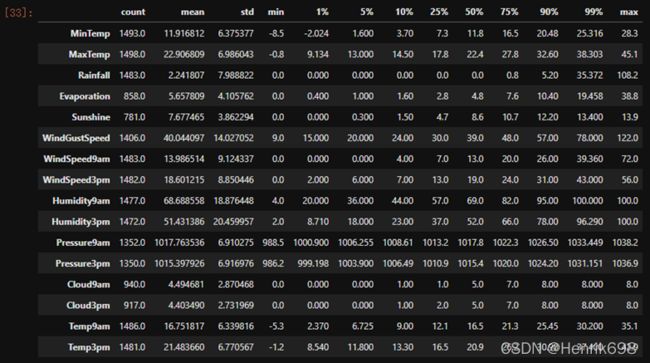
"""
对于去kaggle上下载了数据的小伙伴们,以及坚持要使用完整版数据的(15W行)小伙伴们,如果你发现了异常值,首先你要观察,这个异常值出现的频率
如果异常值只出现了一次,多半是输入错误,直接把异常值删除;
如果异常值出现了多次,去跟业务人员沟通,可能这是某种特殊表示,如果是人为造成的错误,异常值留着是没有用的,只要数据量不是太大,都可以删除;
如果异常值占到你总数据量的10%以上了,不能轻易删除。可以考虑把异常值替换成非异常但是非干扰的项,比如说用0来进行替换,或者把异常当缺失值,用均值或者众数来进行替换。
'''
#下面cell的是处理异常的代码:
#先查看原始的数据结构
Xtrain.shape
Xtest.shape
#观察异常值是大量存在,还是少数存在
Xtrain.loc[Xtrain.loc[:,"Cloud9am"] == 9,"Cloud9am"]
Xtest.loc[Xtest.loc[:,"Cloud9am"] == 9,"Cloud9am"]
Xtest.loc[Xtest.loc[:,"Cloud3pm"] == 9,"Cloud3pm"]
#少数存在,于是采取删除的策略
#注意如果删除特征矩阵,则必须连对应的标签一起删除,特征矩阵的行和标签的行必须要一一对应
Xtrain = Xtrain.drop(index = 71737)
Ytrain = Ytrain.drop(index = 71737)
#删除完毕之后,观察原始的数据结构,确认删除正确
Xtrain.shape
Xtest = Xtest.drop(index = [19646,29632])
Ytest = Ytest.drop(index = [19646,29632])
Xtest.shape
#进行任何行删除之后,千万记得要恢复索引
for i in [Xtrain, Xtest, Ytrain, Ytest]:
i.index = range(i.shape[0])
Xtrain.head()
Xtest.head()
'''
"""
Xtrain.head()

Xtrain.iloc[0,0]

type(Xtrain.iloc[0,0])

Xtrain.iloc[:,0].value_counts()

Xtrain.iloc[:,0].value_counts().count()

Xtrainc = Xtrain.copy()
Xtrainc.sort_values(by="Location")

Xtrain.loc[Xtrain.iloc[:,0] == '2015-08-24',:]

Xtrain["Rainfall"].head(20)
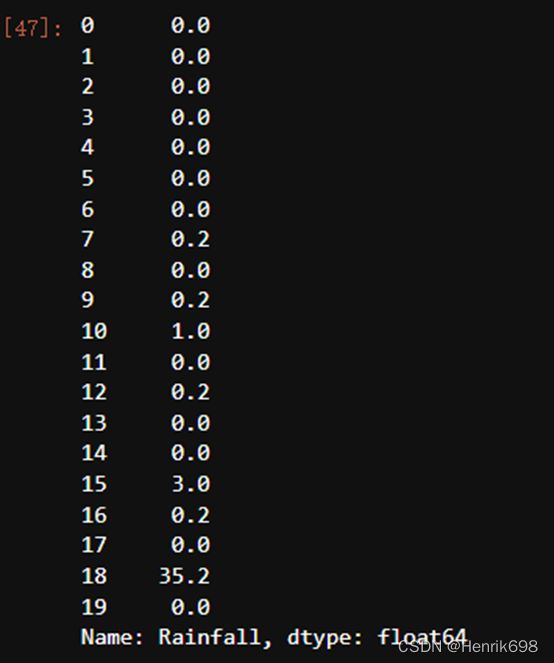
Xtrain["Rainfall"].isnull().sum()

Xtrain.loc[Xtrain["Rainfall"] >= 1,"RainToday"] = "Yes"
Xtrain.loc[Xtrain["Rainfall"] < 1,"RainToday"] = "No"
Xtrain.loc[Xtrain["Rainfall"] == np.nan,"RainToday"] = np.nan
Xtest.loc[Xtest["Rainfall"] >= 1,"RainToday"] = "Yes"
Xtest.loc[Xtest["Rainfall"] < 1,"RainToday"] = "No"
Xtest.loc[Xtest["Rainfall"] == np.nan,"RainToday"] = np.nan
Xtrain.head()

Xtrain.loc[:,'RainToday'].value_counts()

Xtest.head()

Xtest.loc[:,'RainToday'].value_counts()

Xtrain.loc[0,"Date"].split("-")

int(Xtrain.loc[0,"Date"].split("-")[1])

Xtrain["Date"] = Xtrain["Date"].apply(lambda x:int(x.split("-")[1]))
Xtrain.head()

Xtrain.loc[:,'Date'].value_counts()
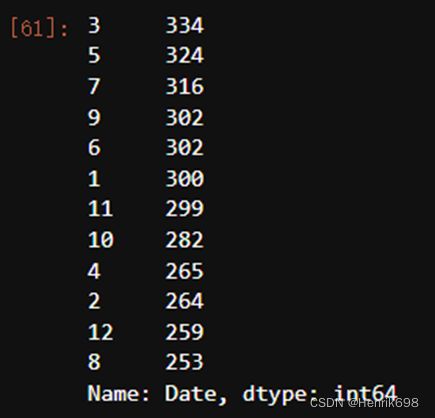
Xtrain = Xtrain.rename(columns={"Date":"Month"})
Xtrain.head()

Xtest["Date"] = Xtest["Date"].apply(lambda x:int(x.split("-")[1]))
Xtest = Xtest.rename(columns={"Date":"Month"})
Xtest.head()

Xtrain.loc[:,'Location'].value_counts().count()

import time
from selenium import webdriver
import pandas as pd
import numpy as np
city = pd.read_csv(r'D:\whole_development_of_the_stack_study\RS_Algorithm_Course\Practical\machine_learning\08_09_10_11SVM_01\Cityclimate.csv')
city.head()
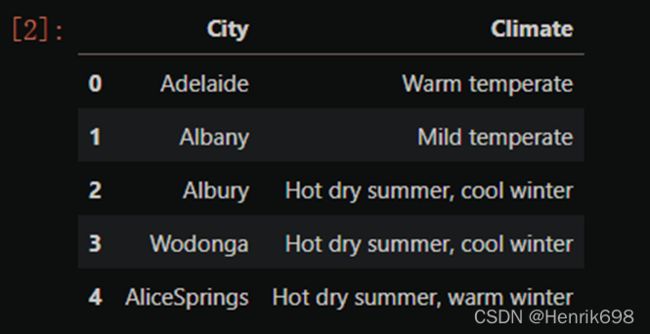
cityname = city.iloc[:,0]
cityname
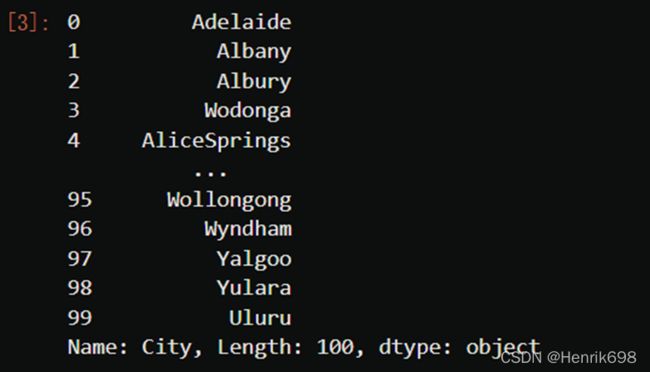
df =pd.DataFrame(index = cityname.index)
driver = webdriver.Chrome()
time0 = time.time()
for num,city in enumerate(cityname):
driver.get('https://www.google.co.uk/webhp?hl=en&sa=X&ved=0ahUKEwimtcX24cTfAhUJE7wKHVkWB5AQPAgH')
time.sleep(1)
search_box = driver.find_element_by_name('q')
search_box.send_keys("%s Australia Latitude and longitude" % (city))
search_box.submit()
result = driver.find_element_by_xpath('//div[@class="Z0LcW"]').text
resultsplit = result.split(" ")
df.loc[num,"City"] = city
df.loc[num,"Latitude"] = resultsplit[0]
df.loc[num,'Longitude'] = resultsplit[2]
df.loc[num,"Latitudedir"] = resultsplit[1]
df.loc[num,"Longitudedir"] = resultsplit[3]
print("%i webcrawler successful for city %s" %(num, city))
time.sleep(1)
driver.quit()
print(time.time()-time0)
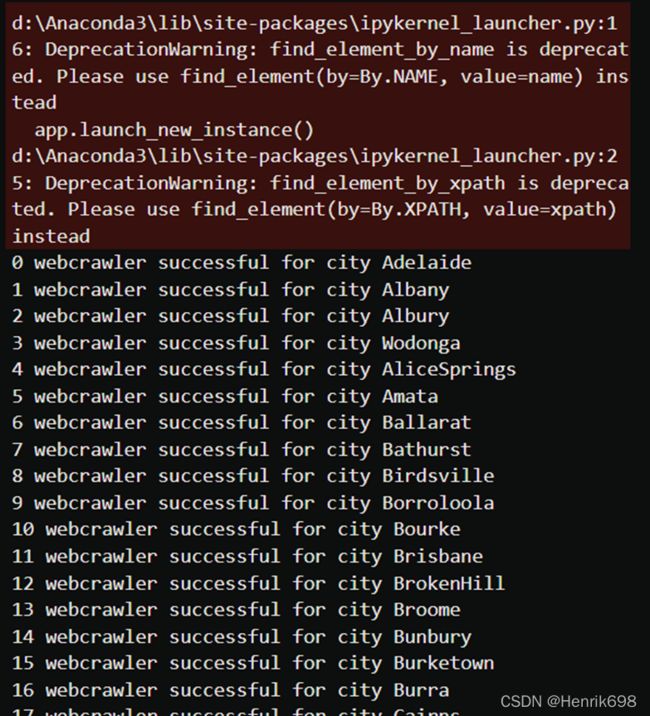
df
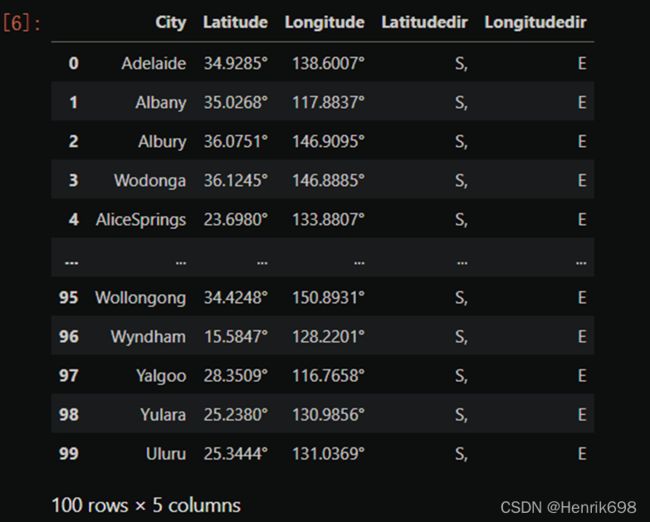
df.to_csv(r"D:\whole_development_of_the_stack_study\RS_Algorithm_Course\Practical\machine_learning\08_09_10_11SVM_01\csv\cityll.csv")
cityll = pd.read_csv(r"D:\whole_development_of_the_stack_study\RS_Algorithm_Course\Practical\machine_learning\08_09_10_11SVM_01\cityll.csv",index_col=0)
city_climate = pd.read_csv(r"D:\whole_development_of_the_stack_study\RS_Algorithm_Course\Practical\machine_learning\08_09_10_11SVM_01\Cityclimate.csv")
cityll.head()

city_climate.head()
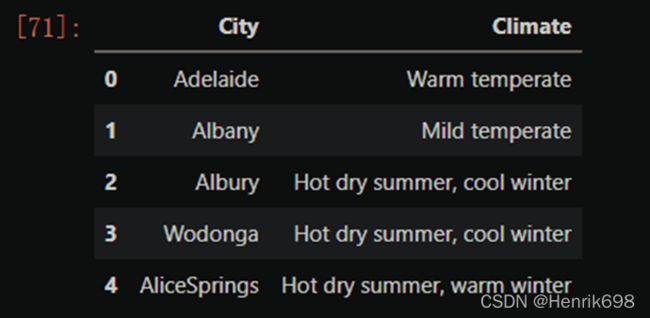
float(cityll.loc[0,'Latitude'][:-1])

cityll["Latitudenum"] = cityll["Latitude"].apply(lambda x:float(x[:-1]))
cityll["Longitudenum"] = cityll["Longitude"].apply(lambda x:float(x[:-1]))
cityll.head()

cityll.loc[:,"Latitudedir"].value_counts()

citylld = cityll.iloc[:,[0,5,6]]
citylld
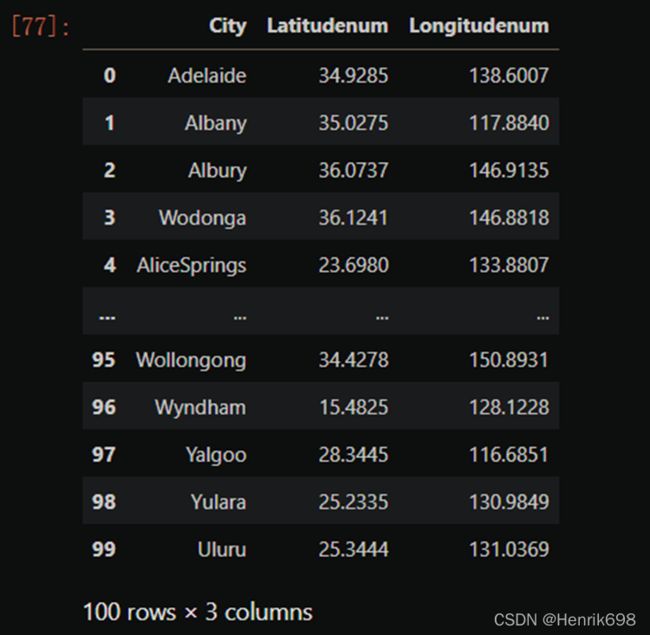
citylld["climate"] = city_climate.iloc[:,-1]
citylld.head()

citylld.loc[:,"climate"].value_counts()
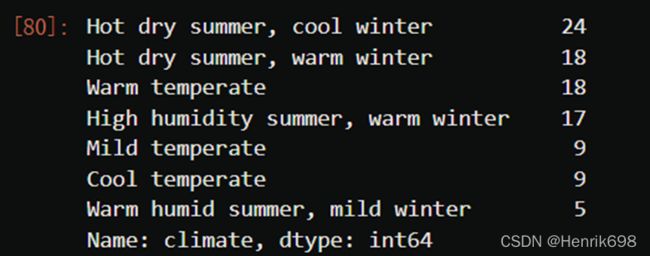
import pandas as pd
import numpy as np
from sklearn.model_selection import train_test_split
weather = pd.read_csv(r"D:\whole_development_of_the_stack_study\RS_Algorithm_Course\Practical\machine_learning\08_09_10_11SVM_01\weatherAUS5000.csv",index_col=0)
X = weather.iloc[:,:-1]
Y = weather.iloc[:,-1]
Xtrain, Xtest, Ytrain, Ytest = train_test_split(X,Y,test_size=0.3,random_state=420)
for i in [Xtrain, Xtest, Ytrain, Ytest]:
i.index = range(i.shape[0])
cityname = Xtrain.iloc[:,1].value_counts().index.tolist()
cityname

import time
from selenium import webdriver
df = pd.DataFrame(index=range(len(cityname)))
driver = webdriver.Chrome()
time0 = time.time()
for num, city in enumerate(cityname):
driver.get('https://www.google.co.uk/webhp?hl=en&sa=X&ved=0ahUKEwimtcX24cTfAhUJE7wKHVkWB5AQPAgH')
time.sleep(0.5)
search_box = driver.find_element_by_name('q')
search_box.send_keys('%s Australia Latitude and longitude' % (city))
search_box.submit()
result = driver.find_element_by_xpath('//div[@class="Z0LcW"]').text
resultsplit = result.split(" ")
df.loc[num,"City"] = city
df.loc[num,"Latitude"] = resultsplit[0]
df.loc[num,"Longitude"] = resultsplit[2]
df.loc[num,"Latitudedir"] = resultsplit[1]
df.loc[num,"Longitudedir"] = resultsplit[3]
print("%i webcrawler successful for city %s" % (num,city))
time.sleep(1)
driver.quit()
print(time.time() - time0)

df
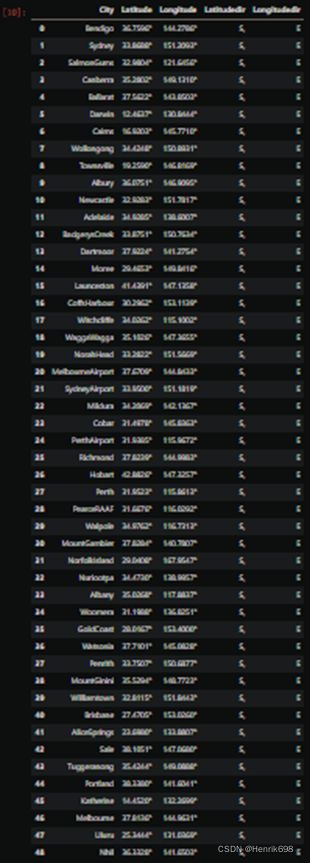
df.to_csv(r"D:\whole_development_of_the_stack_study\RS_Algorithm_Course\Practical\machine_learning\08_09_10_11SVM_01\csv\samplecity.csv")
samplecity = pd.read_csv(r"D:\whole_development_of_the_stack_study\RS_Algorithm_Course\Practical\machine_learning\08_09_10_11SVM_01\samplecity.csv",index_col=0)
samplecity.head()
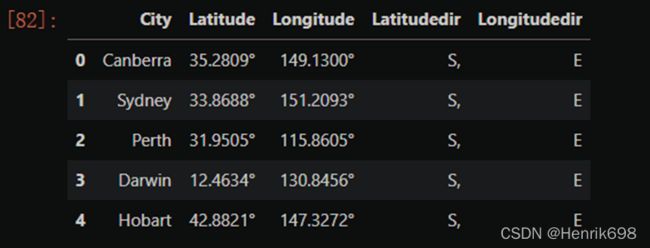
samplecity["Latitudenum"] = samplecity["Latitude"].apply(lambda x:float(x[:-1]))
samplecity["Longitudenum"] = samplecity["Longitude"].apply(lambda x:float(x[:-1]))
samplecityd = samplecity.iloc[:,[0,5,6]]
samplecityd.head()
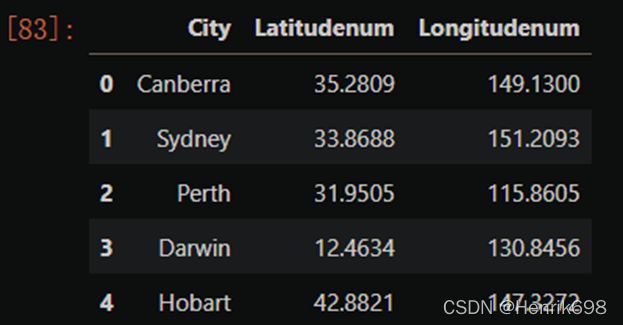

from math import radians, sin, cos, acos
citylld.loc[:,"slat"] = citylld.iloc[:,1].apply(lambda x : radians(x))
citylld.loc[:,"slon"] = citylld.iloc[:,2].apply(lambda x : radians(x))
samplecityd.loc[:,"elat"] = samplecityd.iloc[:,1].apply(lambda x : radians(x))
samplecityd.loc[:,"elon"] = samplecityd.iloc[:,2].apply(lambda x : radians(x))
citylld.head()
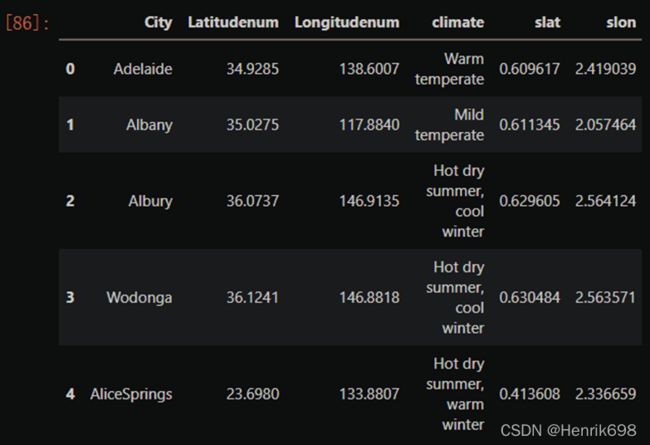
samplecityd.head()
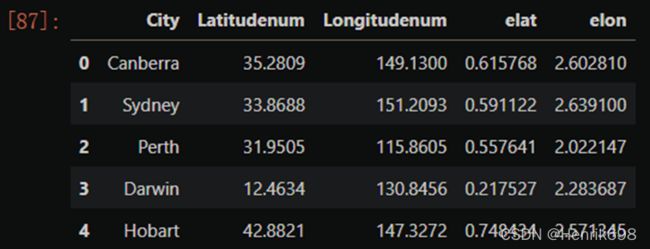
slat = citylld.loc[:,"slat"]
slat
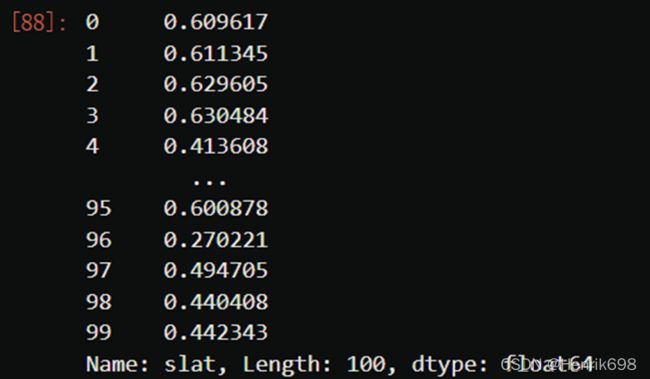
import sys
for i in range(samplecityd.shape[0]):
slat = citylld.loc[:,"slat"]
slon = citylld.loc[:,"slon"]
elat = samplecityd.loc[i,"elat"]
elon = samplecityd.loc[i,"elon"]
dist = 6371.01 * np.arccos(np.sin(slat)*np.sin(elat) +
np.cos(slat)*np.cos(elat)*np.cos(slon.values - elon))
city_index = np.argsort(dist)[0]
samplecityd.loc[i,"closest_city"] = citylld.loc[city_index,"City"]
samplecityd.loc[i,"climate"] = citylld.loc[city_index,"climate"]
samplecityd.head(5)

samplecityd["climate"].value_counts()
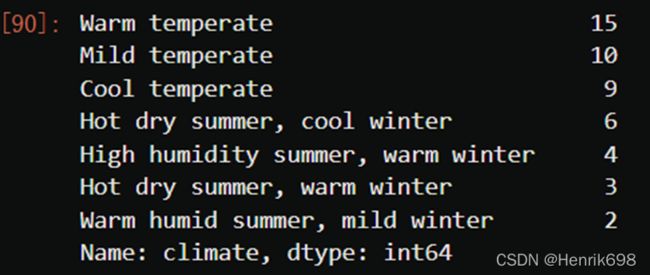
locafinal = samplecityd.iloc[:,[0,-1]]
locafinal.head()
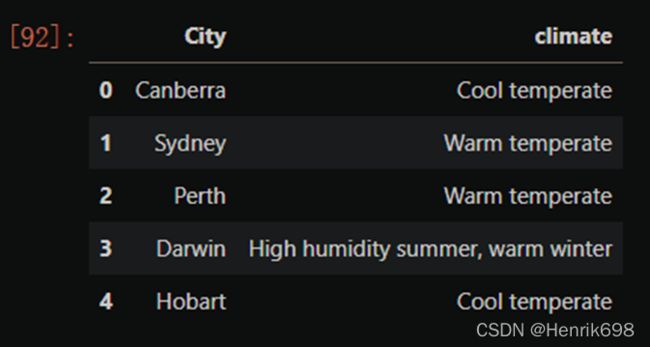
locafinal.columns = ["Location","Climate"]
locafinal.head()
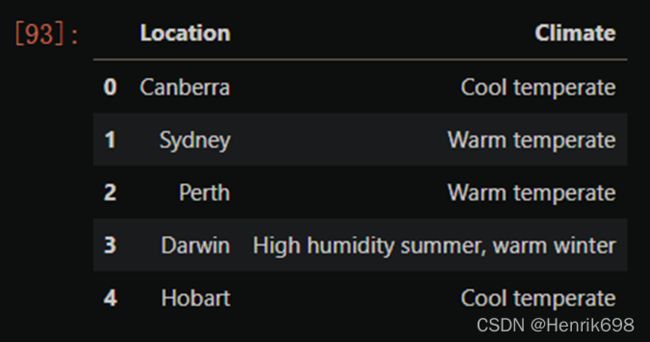
locafinal = locafinal.set_index(keys="Location")
locafinal
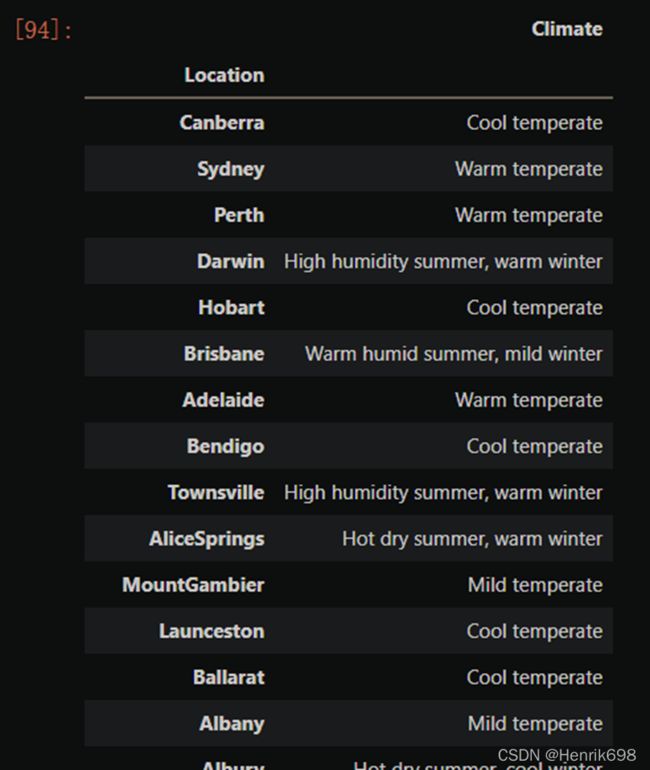
locafinal.to_csv(r"D:\whole_development_of_the_stack_study\RS_Algorithm_Course\Practical\machine_learning\08_09_10_11SVM_01\samplelocation.csv")
locafinal.head()
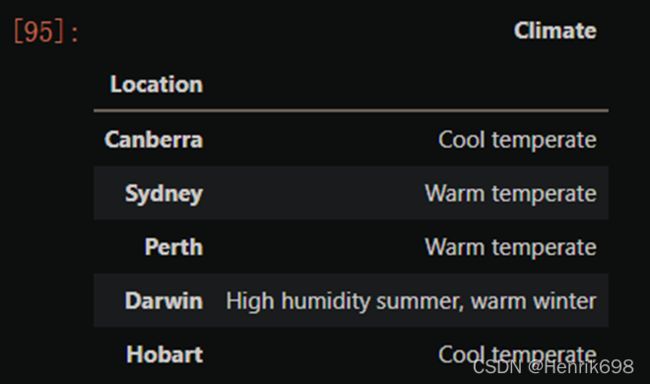
Xtrain.head()

import re
Xtrain["Location"] = Xtrain["Location"].map(locafinal.iloc[:,0])
Xtrain.head()

Xtrain["Location"] = Xtrain["Location"].apply(lambda x:re.sub(",","",x.strip()))
Xtrain.head()

Xtest["Location"] = Xtest["Location"].map(locafinal.iloc[:,0]).apply(lambda x:re.sub(",","",x.strip()))
Xtrain = Xtrain.rename(columns={"Location":"Climate"})
Xtest = Xtest.rename(columns={"Location":"Climate"})
Xtrain.head()

Xtest.head()

Xtrain.isnull().mean()
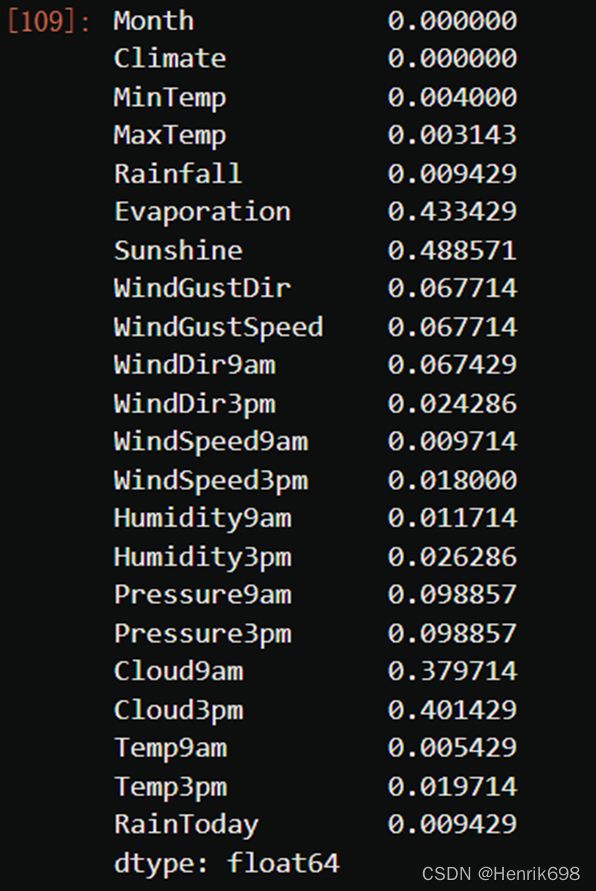
Xtrain.info()
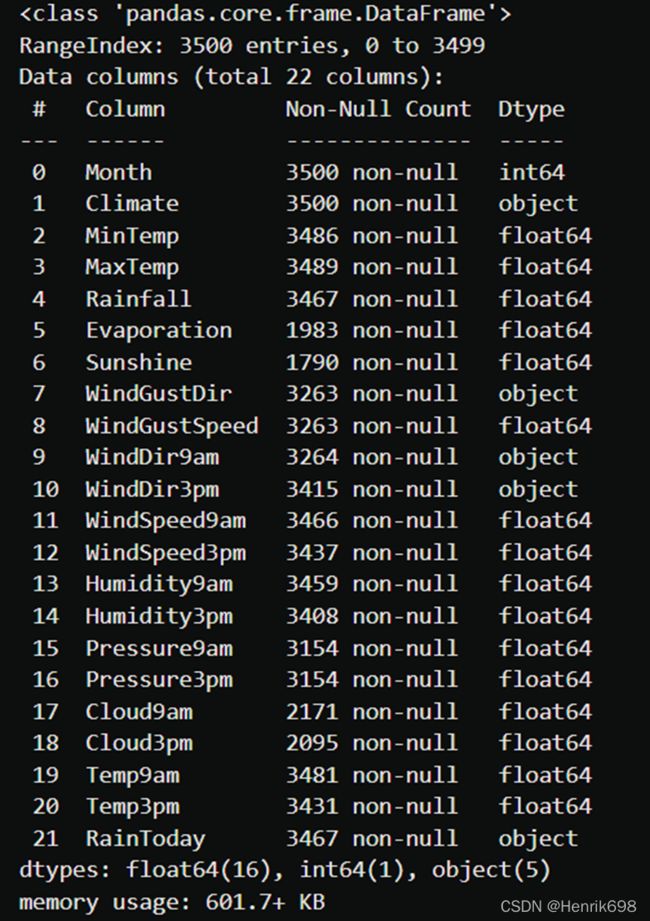
Xtrain.dtypes
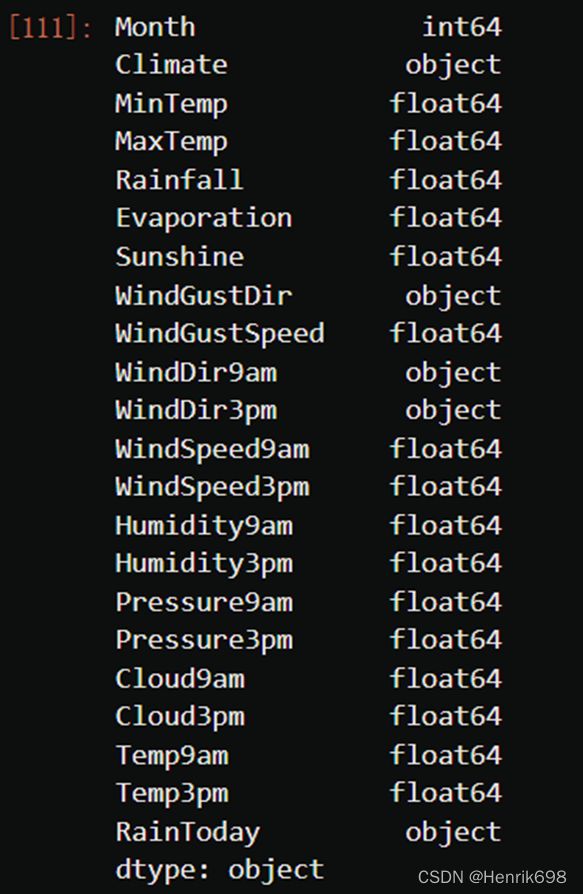
Xtrain.dtypes == 'object'
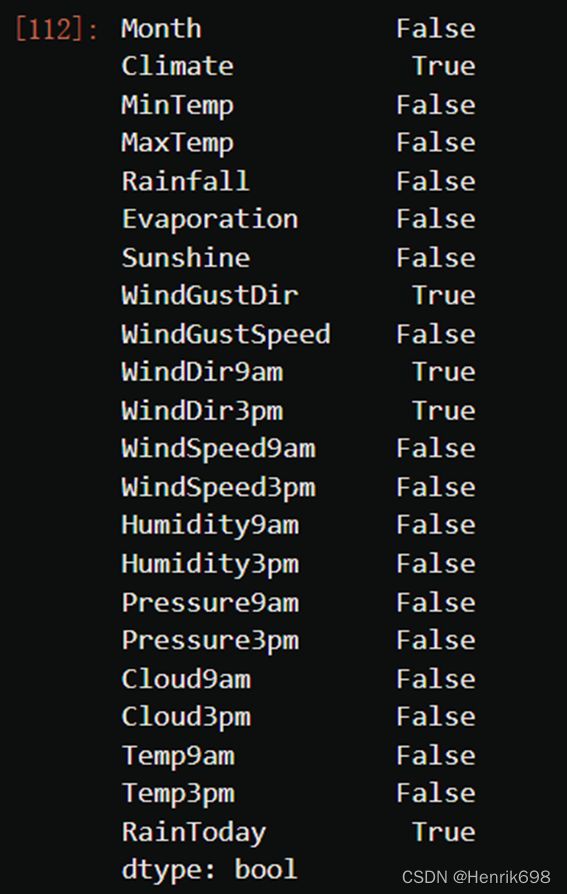
Xtrain.columns

cate = Xtrain.columns[Xtrain.dtypes == "object"].tolist()
cate

cloud = ["Cloud9am","Cloud3pm"]
cate = cate + cloud
cate
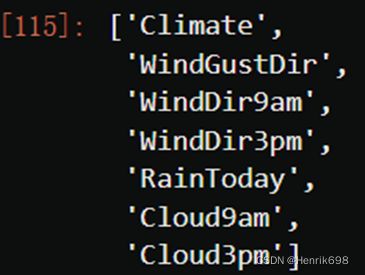
from sklearn.impute import SimpleImputer
si = SimpleImputer(missing_values=np.nan, strategy="most_frequent")
si.fit(Xtrain.loc[:,cate])

Xtrain.loc[:,cate] = si.transform(Xtrain.loc[:,cate])
Xtest.loc[:,cate] = si.transform(Xtest.loc[:,cate])
Xtrain.head()

Xtest.head()

Xtrain.loc[:,cate].isnull().mean()
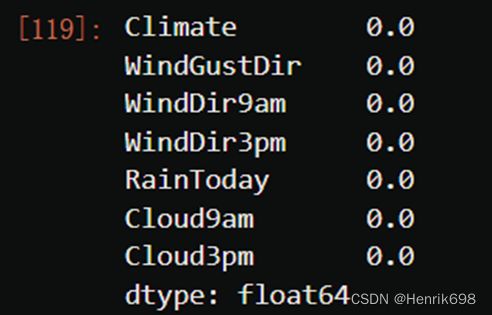
Xtest.loc[:,cate].isnull().mean()
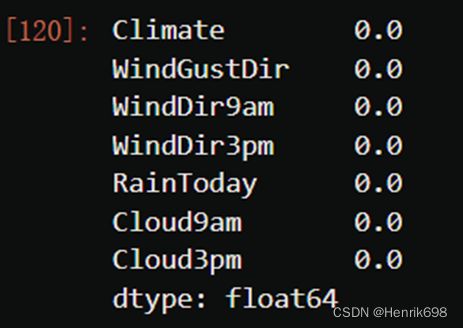
(5)处理分类型变量:将分类型变量编码
from sklearn.preprocessing import OrdinalEncoder
oe = OrdinalEncoder()
oe = oe.fit(Xtrain.loc[:,cate])
Xtrain.loc[:,cate] = oe.transform(Xtrain.loc[:,cate])
Xtest.loc[:,cate] = oe.transform(Xtest.loc[:,cate])
Xtrain.loc[:,cate].head()

Xtest.loc[:,cate].head()

Xtrain.head()

(6)处理连续型变量:填补缺失值
Xtrain.columns

col = Xtrain.columns.tolist()
col
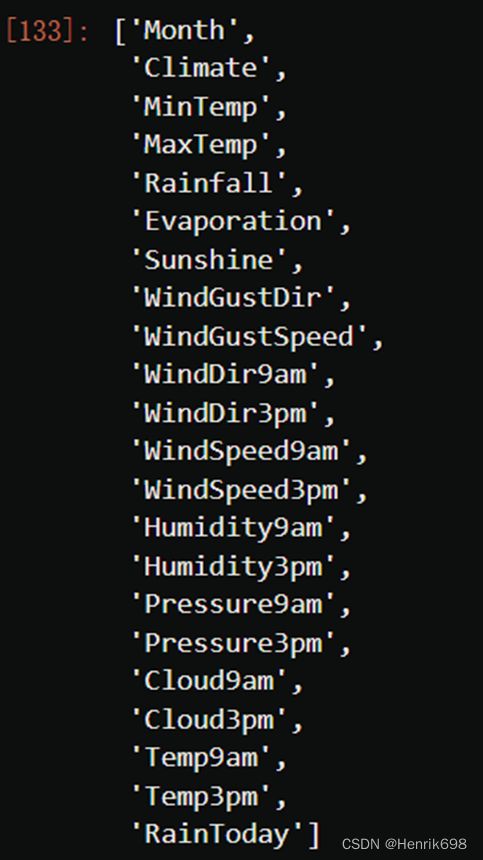
cate
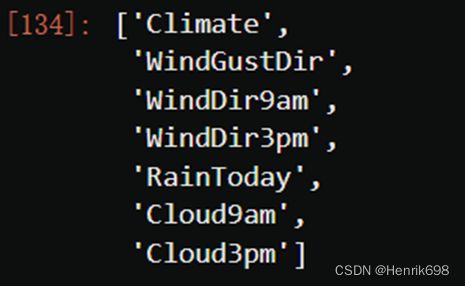
for i in cate:
col.remove(i)
col

impmean = SimpleImputer(missing_values=np.nan,strategy = "mean")
impmean = impmean.fit(Xtrain.loc[:,col])
Xtrain.loc[:,col] = impmean.transform(Xtrain.loc[:,col])
Xtest.loc[:,col] = impmean.transform(Xtest.loc[:,col])
Xtrain.isnull().sum()
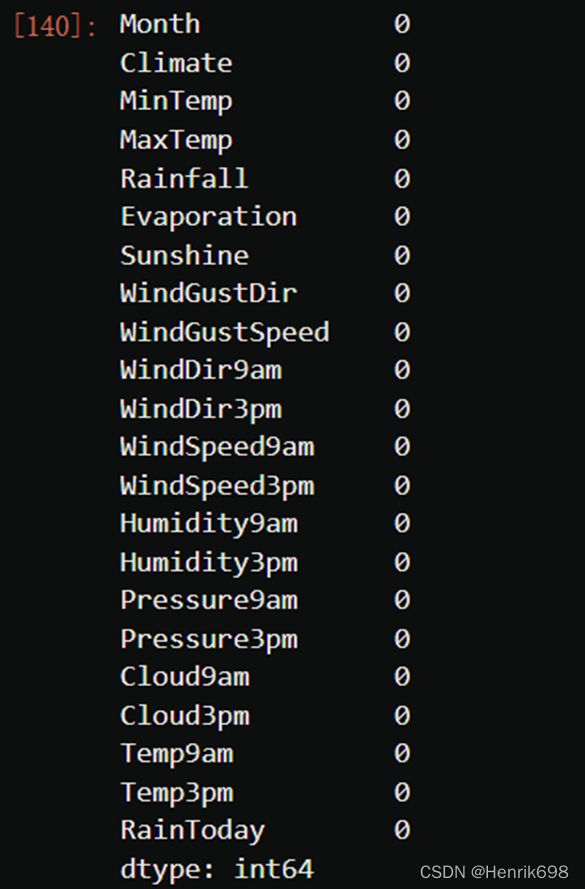
Xtest.isnull().sum()
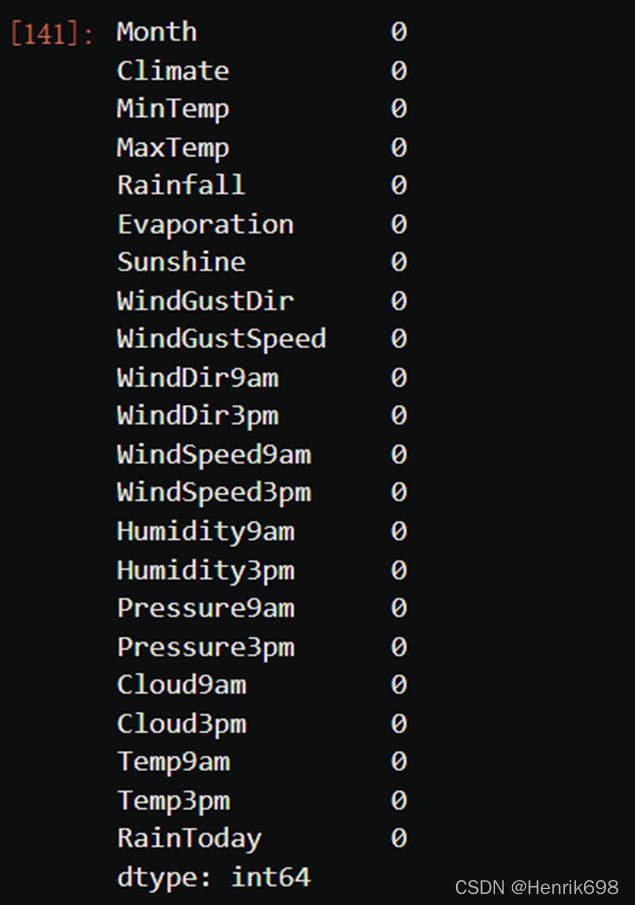
cate
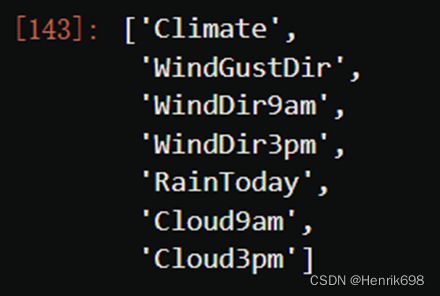
col.remove("Month")
col
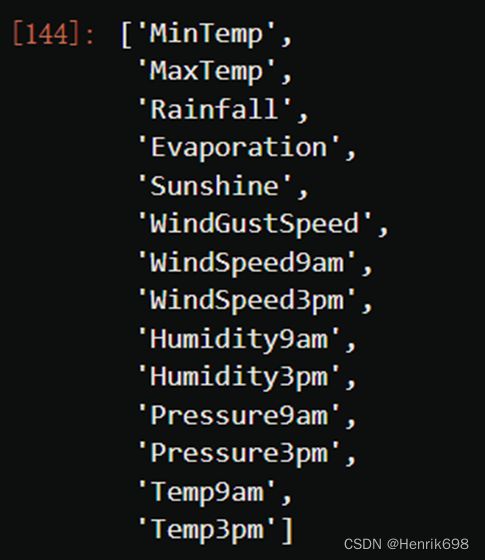
from sklearn.preprocessing import StandardScaler
ss = StandardScaler()
ss = ss.fit(Xtrain.loc[:,col])
Xtrain.loc[:,col] = ss.transform(Xtrain.loc[:,col])
Xtest.loc[:,col] = ss.transform(Xtest.loc[:,col])
Xtrain.head()

Xtest.head()

from time import time
import datetime
from sklearn.svm import SVC
from sklearn.model_selection import cross_val_score
from sklearn.metrics import roc_auc_score, recall_score
Ytrain = Ytrain.iloc[:,0].ravel()
Ytest = Ytest.iloc[:,0].ravel()
times = time()
for kernel in ["linear","poly","rbf","sigmoid"]:
clf = SVC(kernel = kernel
,gamma="auto"
,degree = 1
,cache_size = 10000
).fit(Xtrain, Ytrain)
result = clf.predict(Xtest)
score = clf.score(Xtest,Ytest)
recall = recall_score(Ytest, result)
auc = roc_auc_score(Ytest,clf.decision_function(Xtest))
print("%s 's testing accuracy %f, recall is %f', auc is %f" %(kernel,score,recall,auc))
print(datetime.datetime.fromtimestamp(time()-times).strftime("%M:%S:%f"))

5、模型调参
(1)追求最高Recall
times = time()
for kernel in ["linear","poly","rbf","sigmoid"]:
clf = SVC(kernel = kernel
,gamma="auto"
,degree = 1
,cache_size = 10000
,class_weight = "balanced"
).fit(Xtrain, Ytrain)
result = clf.predict(Xtest)
score = clf.score(Xtest,Ytest)
recall = recall_score(Ytest, result)
auc = roc_auc_score(Ytest,clf.decision_function(Xtest))
print("%s 's testing accuracy %f, recall is %f', auc is %f" %(kernel,score,recall,auc))
print(datetime.datetime.fromtimestamp(time()-times).strftime("%M:%S:%f"))

times = time()
clf = SVC(kernel = "linear"
,gamma="auto"
,cache_size = 10000
,class_weight = {1:10}
).fit(Xtrain, Ytrain)
result = clf.predict(Xtest)
score = clf.score(Xtest,Ytest)
recall = recall_score(Ytest, result)
auc = roc_auc_score(Ytest,clf.decision_function(Xtest))
print("testing accuracy %f, recall is %f', auc is %f" %(score,recall,auc))
print(datetime.datetime.fromtimestamp(time()-times).strftime("%M:%S:%f"))

valuec = pd.Series(Ytest).value_counts()
valuec
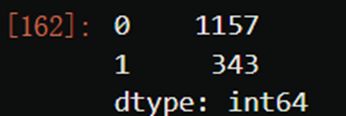
valuec[0]/valuec.sum()

from sklearn.metrics import confusion_matrix as CM
clf = SVC(kernel = "linear"
,gamma="auto"
,cache_size = 5000
).fit(Xtrain, Ytrain)
result = clf.predict(Xtest)
result

cm = CM(Ytest,result,labels=(1,0))
cm

specificity = cm[1,1]/cm[1,:].sum()
specificity

irange = np.linspace(0.01,0.05,10)
irange

for i in irange:
times = time()
clf = SVC(kernel = "linear"
,gamma="auto"
,cache_size = 10000
,class_weight = {1:1+i}
).fit(Xtrain, Ytrain)
result = clf.predict(Xtest)
score = clf.score(Xtest,Ytest)
recall = recall_score(Ytest, result)
auc = roc_auc_score(Ytest,clf.decision_function(Xtest))
print("under ratio 1:%f testing accuracy %f, recall is %f', auc is %f" %(1+i,score,recall,auc))
print(datetime.datetime.fromtimestamp(time()-times).strftime("%M:%S:%f"))
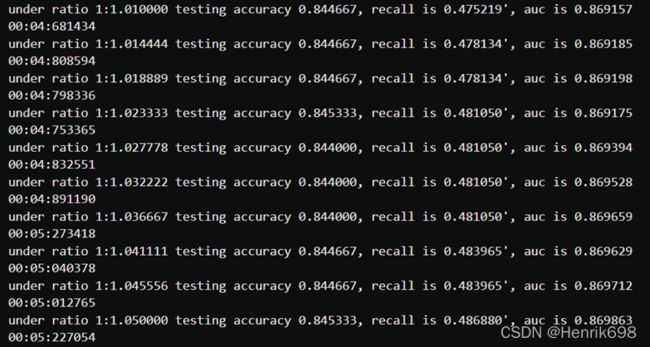
irange_ = np.linspace(0.018889,0.027778,10)
for i in irange_:
times = time()
clf = SVC(kernel = "linear"
,gamma="auto"
,cache_size = 10000
,class_weight = {1:1+i}
).fit(Xtrain, Ytrain)
result = clf.predict(Xtest)
score = clf.score(Xtest,Ytest)
recall = recall_score(Ytest, result)
auc = roc_auc_score(Ytest,clf.decision_function(Xtest))
print("under ratio 1:%f testing accuracy %f, recall is %f', auc is %f" %(1+i,score,recall,auc))
print(datetime.datetime.fromtimestamp(time()-times).strftime("%M:%S:%f"))
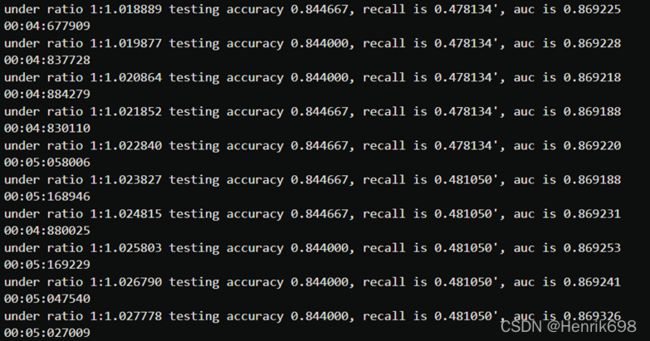
from sklearn.linear_model import LogisticRegression as LR
logclf = LR(solver="liblinear").fit(Xtrain, Ytrain)
logclf.score(Xtest,Ytest)

C_range = np.linspace(3,5,10)
for C in C_range:
logclf = LR(solver="liblinear",C=C).fit(Xtrain, Ytrain)
print(C,logclf.score(Xtest,Ytest))
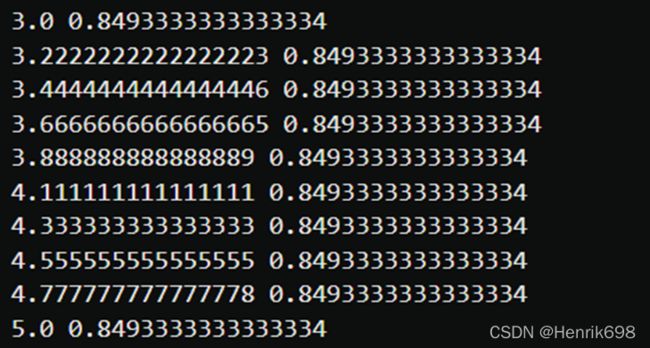
import matplotlib.pyplot as plt
C_range = np.linspace(0.01,20,20)
recallall = []
aucall = []
scoreall = []
for C in C_range:
times = time()
clf = SVC(kernel = "linear",C=C,cache_size = 20000
,class_weight = "balanced"
).fit(Xtrain, Ytrain)
result = clf.predict(Xtest)
score = clf.score(Xtest,Ytest)
recall = recall_score(Ytest, result)
auc = roc_auc_score(Ytest,clf.decision_function(Xtest))
recallall.append(recall)
aucall.append(auc)
scoreall.append(score)
print("under C %f, testing accuracy is %f,recall is %f', auc is %f" %(C,score,recall,auc))
print(datetime.datetime.fromtimestamp(time()-times).strftime("%M:%S:%f"))
print(max(aucall),C_range[aucall.index(max(aucall))])
plt.figure()
plt.plot(C_range,recallall,c="red",label="recall")
plt.plot(C_range,aucall,c="black",label="auc")
plt.plot(C_range,scoreall,c="orange",label="accuracy")
plt.legend()
plt.show()
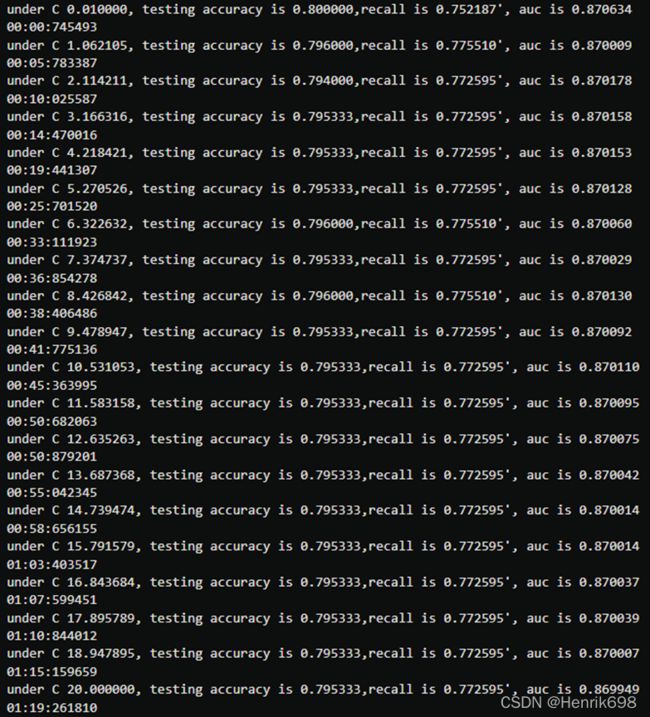

times = time()
clf = SVC(kernel = "linear",C=3.1663157894736838,cache_size = 5000
,class_weight = "balanced"
).fit(Xtrain, Ytrain)
result = clf.predict(Xtest)
score = clf.score(Xtest,Ytest)
recall = recall_score(Ytest, result)
auc = roc_auc_score(Ytest,clf.decision_function(Xtest))
print("testing accuracy %f,recall is %f', auc is %f" % (score,recall,auc))
print(datetime.datetime.fromtimestamp(time()-times).strftime("%M:%S:%f"))

from sklearn.metrics import roc_curve as ROC
import matplotlib.pyplot as plt
FPR, Recall, thresholds = ROC(Ytest,clf.decision_function(Xtest),pos_label=1)
area = roc_auc_score(Ytest,clf.decision_function(Xtest))
plt.figure()
plt.plot(FPR, Recall, color='red',
label='ROC curve (area = %0.2f)' % area)
plt.plot([0, 1], [0, 1], color='black', linestyle='--')
plt.xlim([-0.05, 1.05])
plt.ylim([-0.05, 1.05])
plt.xlabel('False Positive Rate')
plt.ylabel('Recall')
plt.title('Receiver operating characteristic example')
plt.legend(loc="lower right")
plt.show()

maxindex = (Recall - FPR).tolist().index(max(Recall - FPR))
thresholds[maxindex]

from sklearn.metrics import accuracy_score as AC
times = time()
clf = SVC(kernel = "linear",C=3.1663157894736838,cache_size = 5000
,class_weight = "balanced"
).fit(Xtrain, Ytrain)
prob = pd.DataFrame(clf.decision_function(Xtest))
prob.loc[prob.iloc[:,0] >= thresholds[maxindex],"y_pred"]=1
prob.loc[prob.iloc[:,0] < thresholds[maxindex],"y_pred"]=0
prob.head()

prob.loc[:,"y_pred"].isnull().sum()

score = AC(Ytest,prob.loc[:,"y_pred"].values)
recall = recall_score(Ytest, prob.loc[:,"y_pred"])
print("testing accuracy %f,recall is %f" % (score,recall))
print(datetime.datetime.fromtimestamp(time()-times).strftime("%M:%S:%f"))

![]()
![]()
![]()
![]()
![]()
![]()
![]()
![]()
![]()
![]()































































































